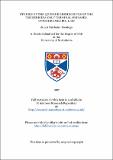Studies of the quinone binding sites of the 'Escherichia coli' terminal oxidases, cytochromes bo₃ & bd
Abstract
The structure and function relationships involved in the binding of quinones to the terminal oxidases of Escherichia coli, cytochromes bd and bo3, were investigated using redox potentiometery, site-directed mutagenesis and magnetic resonance techniques. A stable semiquinone was identified as an intermediate of quinol oxidation by cytochrome bd in appropriately poised samples of both the membrane-bound and purified enzyme reconstituted with excess ubi- and menaquinone analogues. The effects of the inhibitors HOQNO and aurachin D on semiquinone formation were assessed. The potentiometric behaviour of the semiquinone stabilised by membrane-bound and purified cytochrome bo3, reconstituted with excess quinone analogues was characterised. The effects of two cytochrome bo3 subunit II mutations and the inhibitor tridecylstigmatellin were studied. The data presented is consistent with the presence of one quinone binding site. The hyperfine splittings present in the ESR spectrum of the cytochrome bo3 semiquinone were resolved by ENDOR spectroscopy. The resultant electronic structure of the bound semiquinone and the nature of the hydrogen bonding to the protein is described. ESEEM spectroscopy was used to identify a nitrogen nucleus hydrogen bonded to the semiquinone. A model of this quinone binding site and a possible location is presented.
Type
Thesis, PhD Doctor of Philosophy
Collections
Items in the St Andrews Research Repository are protected by copyright, with all rights reserved, unless otherwise indicated.

